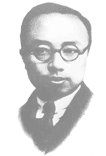Liu Tianhua facts for kids
Quick facts for kids
Liu Tianhua
|
|
|---|---|
 |
|
| Background information | |
| Born | 1895 Jiangyin, Jiangsu, China |
| Origin | Jiangsu |
| Died | 1932 Beijing |
| Genres | Chinese classical |
| Instruments | Erhu, Pipa |
| Years active | early 1900s |
Liu Tianhua (simplified Chinese: 刘天华; traditional Chinese: 劉天華; pinyin: Liú Tiānhuá; Wade–Giles: Liu T'ien-hua; 1895–1932) was a very important Chinese musician. He was also a talented composer. He is best known for his new ideas for the erhu. The erhu is a two-stringed Chinese fiddle.
Liu Tianhua's students, like Jiang Fengzhi and Chen Zhenduo, helped the erhu grow even more. Liu was the younger brother of the famous poet Liu Bannong. He passed away in 1932 when he was 37 years old.
Contents
Modernizing Chinese Music
Liu Tianhua was a skilled player of both the erhu and the pipa. The pipa is a traditional Chinese lute. He was a leader in making old Chinese music more modern.
In 1922, he became an instructor at Peking University. He joined the university's Music Society. While there, he worked hard to promote Chinese music.
Improving Traditional Instruments
Liu Tianhua started the Society for the Improvement of Chinese Music in 1927. This group helped to make Chinese music better. They also published a magazine called Music Magazine.
The society held music classes. They also created a musical group. This group played Chinese music together. It was an early version of what we now call a modern Chinese orchestra.
Liu made important changes to the traditional Chinese fiddle, called the huqin. He especially improved the erhu. His changes made the erhu a better instrument for stage performances. He also wrote many pieces of music for it.
He also changed the pipa. He added more frets to it. He also used a special way of tuning called equal-tempered tuning. This made the pipa sound more in tune with other instruments.
Liu Tianhua's Compositions
Liu Tianhua wrote many pieces of music. Here are some of his most famous works. The titles are given in Chinese and English.
Erhu Music
- Bìng Zhōng Yín (病中吟) 1918 (Recitation of Ill-Being; Soliloquy of a Convalescent)
- Yuè Yè (月夜) 1924 (Moon Night)
- Kǔmèn zhī Ōu (苦闷之讴) 1926 (Song of Melancholy)
- Bēi Gē (悲歌) 1927 (Song of Lament)
- Liáng Xiāo (良宵) 1928 (Beautiful Evening)
- Xián Jū Yín (闲居吟) 1928 (Recitation of Leisure)
- Kōng Shān Niǎo Yǔ (空山鸟语) 1928 (Bird Song in a Desolate Mountain)
- Guāngmíng Xíng (光明行) 1931 (Towards Brightness)
- Dú Xián Cāo (独弦操) 1932 (Étude on a Single String)
- Zhú Yĭng Yáo Hóng (烛影摇红) 1932 (Shadows of Candles, Flickering Red)
- Studies for Erhu No 1 - 47
Pipa Music
- Gē Wǔ Yǐn (歌舞引) (Dance Prelude)
- Gǎi Jìn Cāo (改進操) (Improved Étude)
- Xū Lài (虛籟) 1929 (Sound of Emptiness)
Ensemble Arrangements

